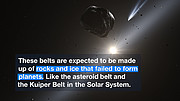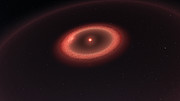Artist’s impression of the dust belts around Proxima Centauri
Proxima Centauri in the southern constellation of Centaurus
The location of Proxima Centauri in the southern skies
The sky around Alpha Centauri and Proxima Centauri (annotated)
Videos
ESOcast 136 Light: ALMA Discovers Cold Dust Around Nearest Star (4K UHD)
There are also hints in the ALMA data of another belt of even colder dust about ten times further out. If confirmed, the nature of an outer belt is intriguing, given its very cold environment far from a star that is cooler and fainter than the Sun. Both belts are much further from Proxima Centauri than the planet Proxima b, which orbits at just four million kilometres from its parent star [3].
Guillem Anglada explains the implications of the discovery: “This result suggests that Proxima Centauri may have a multiple planet system with a rich history of interactions that resulted in the formation of a dust belt. Further study may also provide information that might point to the locations of as yet unidentified additional planets.”
Proxima Centauri's planetary system is also particularly interesting because there are plans — the Starshot project — for future direct exploration of the system with microprobes attached to laser-driven sails. A knowledge of the dust environment around the star is essential for planning such a mission.
Co-author Pedro Amado, also from the Instituto de Astrofísica de Andalucía, explains that this observation is just the start: “These first results show that ALMA can detect dust structures orbiting around Proxima. Further observations will give us a more detailed picture of Proxima's planetary system. In combination with the study of protoplanetary discs around young stars, many of the details of the processes that led to the formation of the Earth and the Solar System about 4600 million years ago will be unveiled. What we are seeing now is just the appetiser compared to what is coming!”
Notes
[1] In a cosmic coincidence, the lead author of the study, Guillem Anglada shares his name with the astronomer who led the team that discovered Proxima Centauri b, Guillem Anglada-Escudé, himself a co-author of the paper in which this research is published, although the two are not related.
[2] Proxima Centauri is quite an old star, of similar age to the Solar System. The dusty belts around it are probably similar to the residual dust in the Kuiper Belt and the asteroid belt in the Solar System and the dust that creates the Zodiacal Light. The spectacular discs that ALMA has imaged around much younger stars, such as HL Tauri, contain much more material that is in the process of forming planets.
[3] The apparent shape of the very faint outer belt, if confirmed, would give astronomers a way to estimate the inclination of the Proxima Centauri planetary system. It would appear elliptical due to the tilt of what is assumed to be in reality a circular ring. This would in turn allow a better determination of the mass of the Proxima b planet, which is currently known only as a lower limit.
More Information
This research was presented in a paper entitled “ALMA Discovery of Dust Belts Around Proxima Centauri”, by Guillem Anglada et al., to appear in Astrophysical Journal Letters.
The team is composed of Guillem Anglada (Instituto de Astrofísica de Andalucía (CSIC), Granada, Spain [IAA-CSIC]), Pedro J. Amado (IAA-CSIC), Jose L. Ortiz (IAA-CSIC), José F. Gómez (IAA-CSIC), Enrique Macías (Boston University, Massachusetts, USA), Antxon Alberdi (IAA-CSIC), Mayra Osorio (IAA-CSIC), José L. Gómez (IAA-CSIC), Itziar de Gregorio-Monsalvo (ESO, Santiago, Chile; Joint ALMA Observatory, Santiago, Chile), Miguel A. Pérez-Torres (IAA-CSIC; Universidad de Zaragoza, Zaragoza, Spain), Guillem Anglada-Escudé (Queen Mary University of London, London, United Kingdom), Zaira M. Berdiñas (Universidad de Chile, Santiago, Chile; IAA-CSIC), James S. Jenkins (Universidad de Chile, Santiago, Chile), Izaskun Jimenez-Serra (Queen Mary University of London, London, United Kingdom), Luisa M. Lara (IAA-CSIC), Maria J. López-González (IAA-CSIC), Manuel López-Puertas (IAA-CSIC), Nicolas Morales (IAA-CSIC), Ignasi Ribas (Institut de Ciències de l’Espai (IEEC-CSIC), Bellaterra, Spain), Anita M. S. Richards (JBCA, University of Manchester, Manchester, United Kingdom), Cristina Rodríguez-López (IAA-CSIC) and Eloy Rodríguez (IAA-CSIC).
ESO is the foremost intergovernmental astronomy organisation in Europe and the world’s most productive ground-based astronomical observatory by far. It is supported by 16 countries: Austria, Belgium, Brazil, the Czech Republic, Denmark, France, Finland, Germany, Italy, the Netherlands, Poland, Portugal, Spain, Sweden, Switzerland and the United Kingdom, along with the host state of Chile and by Australia as a strategic partner. ESO carries out an ambitious programme focused on the design, construction and operation of powerful ground-based observing facilities enabling astronomers to make important scientific discoveries. ESO also plays a leading role in promoting and organising cooperation in astronomical research. ESO operates three unique world-class observing sites in Chile: La Silla, Paranal and Chajnantor. At Paranal, ESO operates the Very Large Telescope and its world-leading Very Large Telescope Interferometer as well as two survey telescopes, VISTA working in the infrared and the visible-light VLT Survey Telescope. ESO is also a major partner in two facilities on Chajnantor, APEX and ALMA, the largest astronomical project in existence. And on Cerro Armazones, close to Paranal, ESO is building the 39-metre Extremely Large Telescope, the ELT, which will become “the world’s biggest eye on the sky”.
Links
Contacts
Guillem Anglada
Instituto de Astrofísica de Andalucía (CSIC)
Granada, Spain
Email: guillem@iaa.es
Pedro J. Amado
Instituto de Astrofísica de Andalucía (CSIC)
Granada, Spain
Email: pja@iaa.csic.es
Antxon Alberdi
Instituto de Astrofísica de Andalucía (CSIC)
Granada, Spain
Email: antxon@iaa.es
Enrique Macias
Boston University
Boston, USA
Email: emacias@bu.edu
Itziar de Gregorio-Monsalvo
ESO/ALMA
Santiago, Chile
Tel: +56 22 4676316
Email: idegrego@eso.org
Richard Hook
ESO Public Information Officer
Garching bei München, Germany
Tel: +49 89 3200 6655
Cell: +49 151 1537 3591
Email: rhook@eso.org
Source: ESO





